You can listen to the tracks in full with a registered Spotify account, which comes for free.
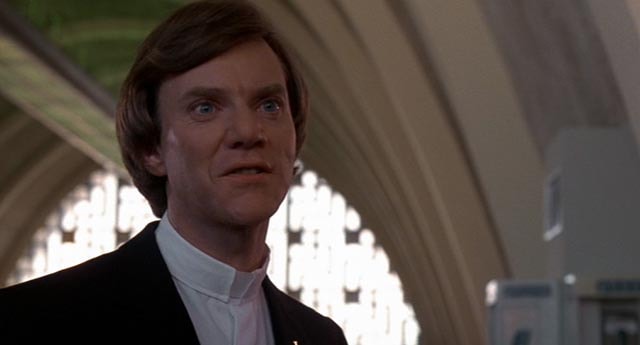
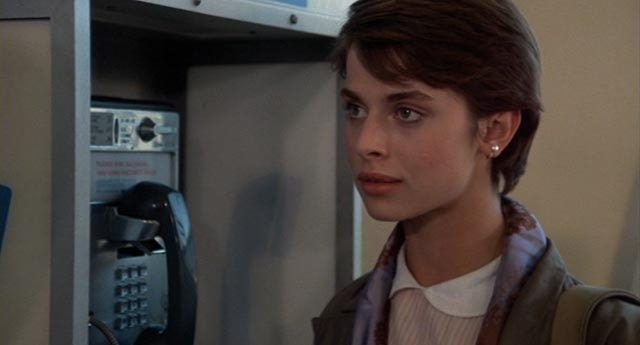

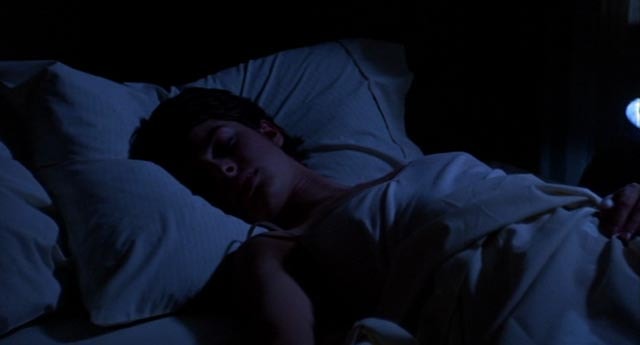
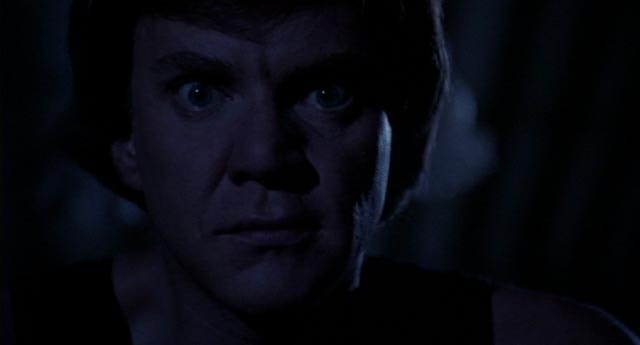

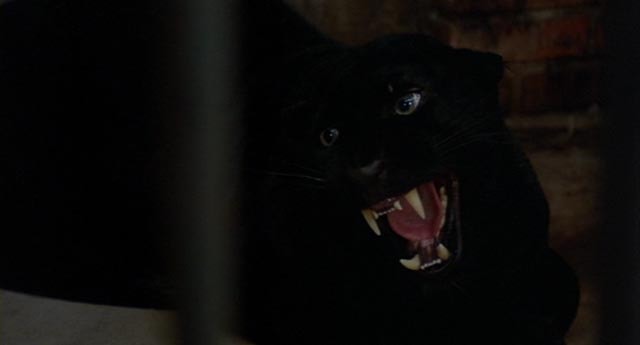




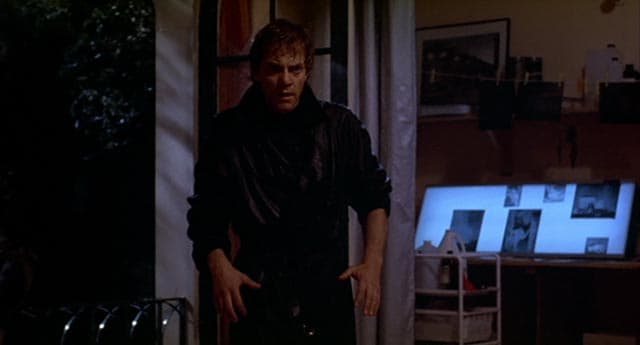




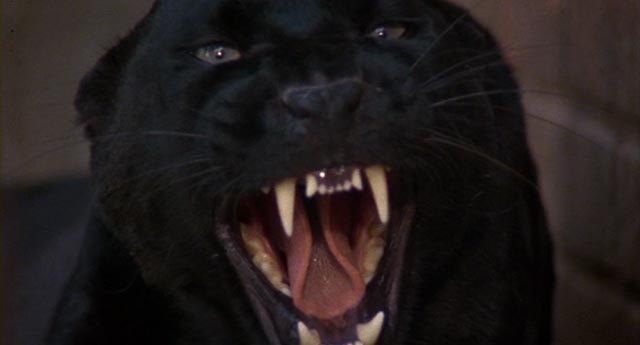











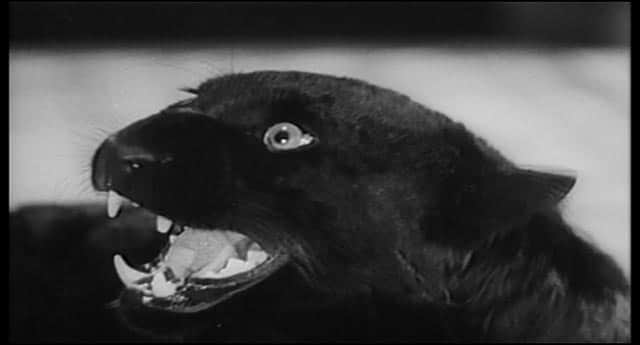






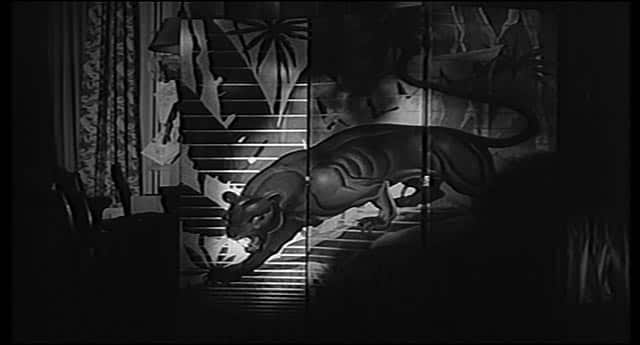
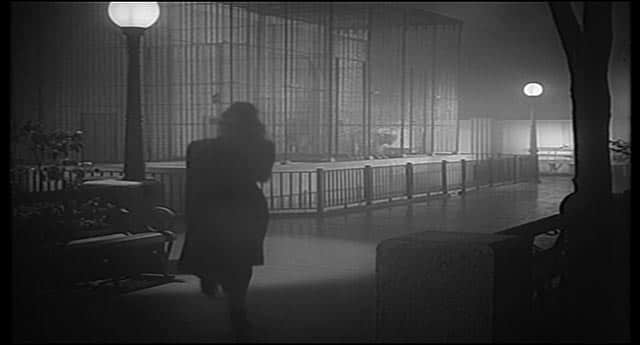



Stills in sequence from the two Cat People films, Paul Schrader & Jacques Tourneur
Cat People
Paul Schrader, 1982 | Jacques Tourneur, 1942
INTERVIEW: PAUL SCHRADER ON ‘CAT PEOPLE’
From Kevin Jackson, Schrader on Schrader (Faber & Faber, 1990) pp. 166-172
When I wrote ‘Born in the USA’ — which I eventually made as Light of Day — I found that I couldn’t get it out at the time, so when the opportunity came in 1979 to do Cat People, which was not a script I had written, I decided to do it in order not to do a personal film. One of the reasons ‘Born in the USA’ was running into difficulties was that it was just too personal, so I said, ‘OK, I’m going to do a genre film, a horror film, a special-effects film that will not be about me, and that will be a very salutary exercise.’ Well, in truth, when I look back on it, I see Cat People as being almost the most personal film I’ve done.

Nastassia Kinski, Cat People, Paul Schrader
That transformation from a genre piece to a personal film come about mainly in the way we evolved the character of the zookeeper played by John Heard as a sort of pursuer of a Beatrice figure. He’s a man who lives with animals because he doesn’t like humans very much. And then his Beatrice appears and his greatest fantasy has come true, because Beatrice is an animal. Well, as we developed the character he evolved more and more along the lines of myself, and then during the actual shooting of the film I became involved with Nastassia Kinski and became obsessed with her. So the story of the film started to become very personal, so much so that I wasn’t really aware of how perverse it was getting. I remember on the opening night going with a producer, Jerry Bruckheimer, to the cinema, and we were sitting in the back row with a group of girls in front of us. And it came to that scene where he is tying her to the bed to the strains of this liturgic, primitive music; it was shot as a religious ceremony but it was a zoophiliac bondage scene, and I remember this girl in front of me going, ‘Oh my God,’ and I turned to Jerry and said, ‘I think we went a little too far here.’

Nastassia Kinski & John Heard, Cat People, Paul Schrader
The Beatrice idea is the opposite side of the coin from the ‘We’ve Gotta Get Out of This Place’ feeling, an idealized version of what the shining goal is, and that may take the form of the redemptive moment or, in sexual terms, the form of Beatrice, the female equivalent of Christ. At university I took a course on Milton, but I was more attracted to Dante because I liked the idea of that sort of romantic obsession. Beatrice was always a more compelling figure to me than Milton’s Satan, even though Satan is one of the great figures in literature. But Taxi Driver has the Beatrice theme, Obsession has it, and, of course, it’s one of the reasons I like Vertigo so much. The image of Beatrice also appears in Cat People in the form of a sculpture, a bust of her which you see at one point; I kept it after we finished the film and it’s still in my study.

Nastassia Kinski, Cat People, Paul Schrader
The original script had a very conventional ending. There was a big dark house and the monster was killed and the house was burned down. So the big change I made was that he doesn’t kill the monster; he makes love to her and puts her in a shrine and lives with her.
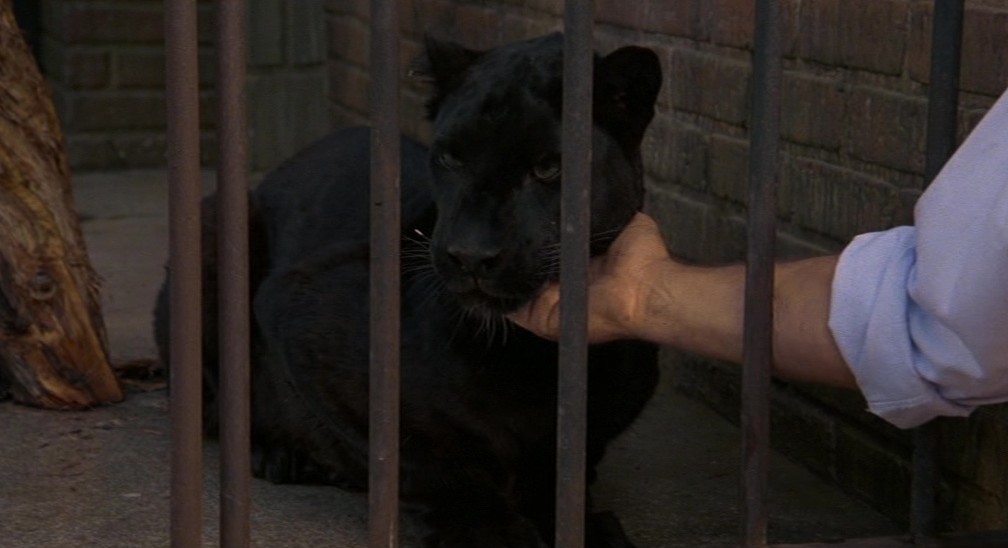
Cat People, Paul Schrader
I like existential horror. I think the greatest metaphor in the cinema is in The Exorcist, where you get God and the Devil in the same room arguing over the body of a little girl. There’s not a more pristine debate imaginable — it’s literally Satan and Jehovah arguing over who will possess this girl. I mean that’s a horror film, that is truly great. In the same way, Rosemary’s Baby has deep spiritual connotations. I like those kind of horror films.

Nastassia Kinski, Cat People, Paul Schrader
The Newsweek review said Cat People was a movie for the Jung at heart, and I guess that’s pretty much what I wanted: the idea of myth and the kind of primal images that are embedded in our genes. The only moment in the film I really regret is in the autopsy scene, where the man’s arm lashes out from the cat’s belly. That was a little too genre for me, but in a film like that you have to have certain of those elements.
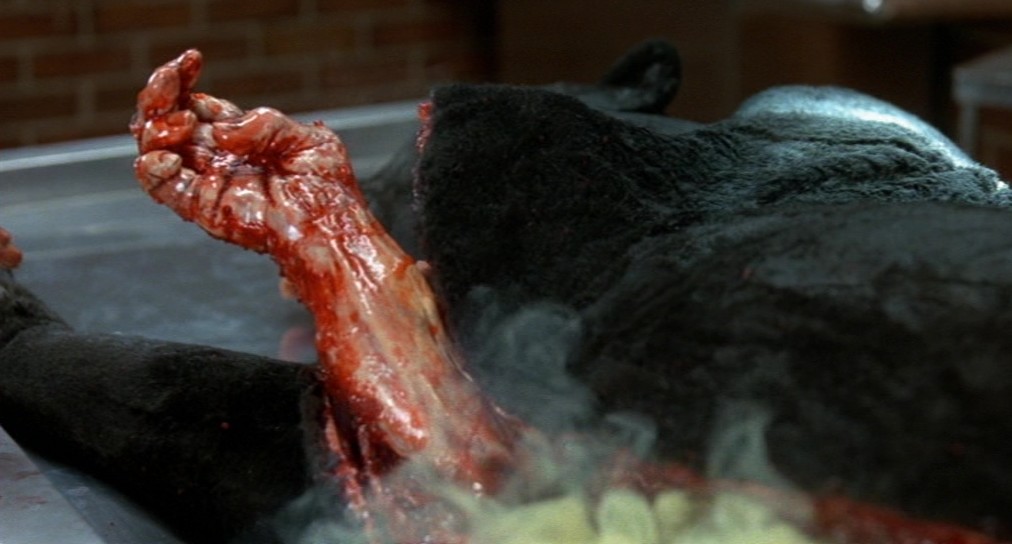
Cat People, Paul Schrader
I am an admirer of The Hero With a Thousand Faces, though I’m a Freudian as well, and I vacillate between the two. But at one time I was a big reader of Joseph Campbell and I’d like to do another mythic kind of film, though it depends on the right circumstances. As we’re talking certain kinds of themes emerge: I move between Kammerspiel films like Hardcore and Light of Day, suicidal glory films like Mishima, existential man-in-his-room stories like Taxi Driver and Gigolo, and Beatrice films like Obsession and this new script, Forever Mine.

Cat People, Paul Schrader
Well, when you shoot any film there are always a couple of tapes you lug along with you and you play them in your office continually with the sound off. On Gigolo, besides The Conformist, it was L’Éclisse; there was something about those angles and that sensibility. And on Cat People the tapes I took along were Beauty and the Beast and Orpheus, which are obviously nonpareil landmarks in the history of movies. There will never be another Cocteau.

Jean Cocteau, Orphée / Orpheus
New Orleans is the most un-American town in America; five different flags have flown over it and it’s the most Latin city in the States. I tried to reflect that in the casting, to have a gumbo kind of cast to tune in with New Orleans’s gumbo-pot of races and nations. The film owes a lot to Nando Scarfiotti; in fact, I tried to get him a co-possessory credit on the film because he was having problems with the union and couldn’t get his proper credit as production designer. Cat People is very colour co-ordinated, in salmon reds and chartreuse greens, right from the opening where you have those green letters coming over red sand.

Ferdinando Scarfiotti, Visual Consultant, Cat People, Paul Schrader
I don’t think much of the 1942 Cat People. It was interesting in its use of shadows and so forth, but I didn’t find it very good and I was perturbed that people were trying to compare the two films.

Kent Smith & Simone Simon, Cat People, Jacques Tourneur
In retrospect, I wish I’d changed the title because then there wouldn’t have been the comparisons. But there are a couple of quotations from it, like the swimming pool scene…

Cat People, Paul Schrader, swimming pool scene

Cat People, Jacques Tourneur, swimming pool scene
… and the scene where Nastassia is in the bar talking to her friend and the woman comes up and says, ‘Mi hermana…’. That’s a little tip of the hat to the original.
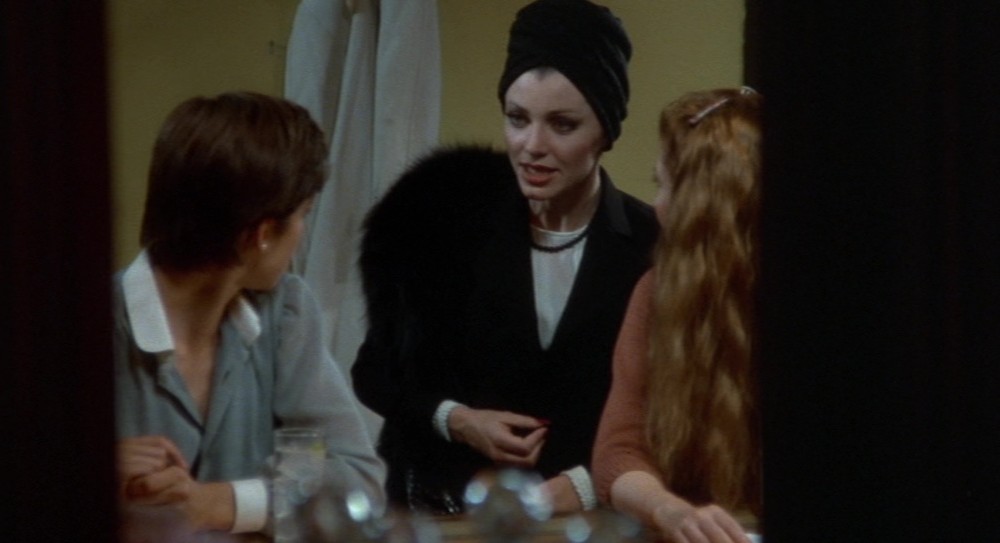
Cat People, Paul Schrader, ‘Mi hermana…’
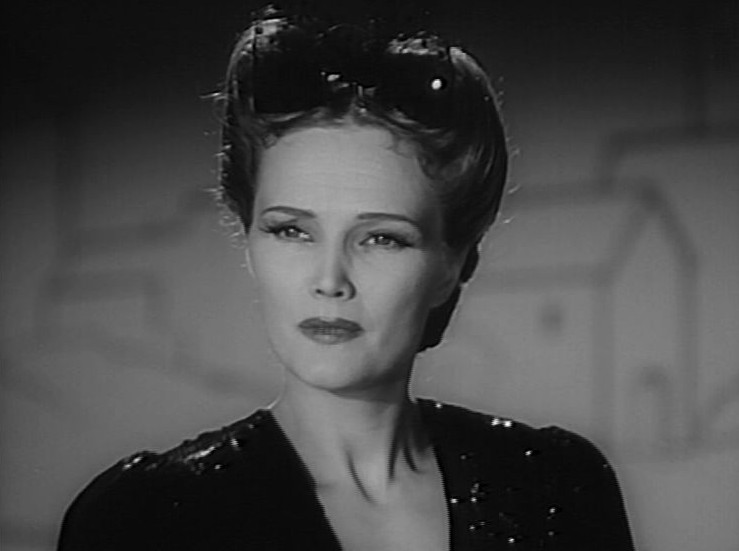
Cat People, Jacques Tourneur, ‘Mi hermana…’
Cat People wasn’t successful. It really fell between two stools: it was an attempt to have things both ways, which is to have a classy film and a horror film. Well, the horror audience went and said, ‘Hey, this doesn’t look like a horror film, it’s not for us’, and the sophisticated audience went and said, ‘Hey, this is just a horror film.’ So it wasn’t really satisfying to the audience.

Malcolm McDowell, Cat People, Paul Schrader
‘CAT PEOPLE’ IN ‘MARA, MARIETTA’
FROM ‘MARA, MARIETTA’
Part Three Chapter 6
̶ This is Aravane.
Dark the tapered arc of the eyebrow descends to the tip of the cat’s ear; on each face—one eye deep in shadow, the other in a flare of light—the same unyielding stare.
̶ What presence!
Falling in a curtain to one side of her head, her hair crops the photo, bringing the faces forward and emphasizing the similarity of the eyes.
̶ And she’s just like that in person—relaxed, yet very intense.
̶ Did you spend much time together?
̶ Two hours. They went by in a flash!
Sitting opposite each other, lotus-like on the bed, we contemplate the woman you’re renting this apartment from.
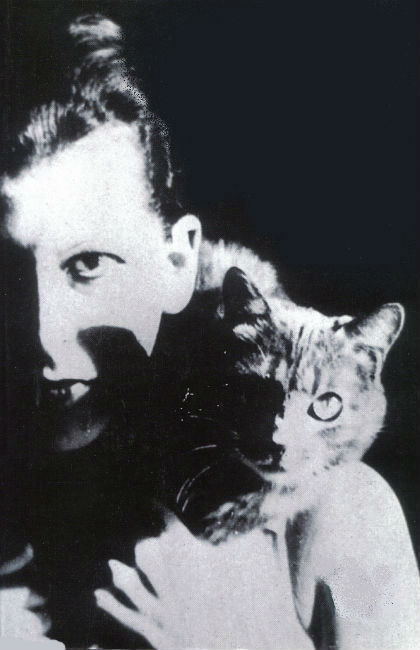
Claude Cahun, Autoportrait avec chat, 1929
̶ I can’t get over this photo, Sprague. It’s mesmerizing!
̶ Yes. There’s definitely something about it. It’s got rhythm, drama, tension.
̶ Yet a profound sense of peace. It’s uncanny!
Nastassia Kinski.

Nastassia Kinski, Cat People, Paul Schrader
̶̶ The cat is clearly tuned in to Aravane’s vibes.
̶ Unless it’s the other way around!
Simone Simon.
̶ Held back, yet penetrating—you’re right, that look is more feline than human.
̶ But face-to-face she’s no different!
Cat People.
̶ Do you like cats, Sprague?
̶ Yes, very much. And you?
Slung over her shoulders like a pelisse, the feline djinni inhabits Aravane’s gaze.
̶ I’d like to like them, but they give me the creeps!
̶ All cats?
̶ Yes, just about.

Simone Simon, Cat People, Jacques Tourneur
Imp of darkness, emblem of sin, hide yourself away on my wedding day: What is it about cats that gets to you? I’d have thought you’d see in cats’ eyes an image of your own independence; I’d have thought you’d see not an enemy of the sun or grimalkin but a cunning creature of forethought and ingenuity: One with whom you could identify.
̶ Pass it to me. I’ll put it back.
Unfolding your legs, you slide off the bed and walk to the far wall. On its stand on the console you place the photograph. Naked, seen from behind, your body is an hourglass that gives a stickiness to time: Suspended in the trickling sand, I hesitate between dream and reality. Was it just a moment ago you kissed my lips? Was it just a moment ago you straddled my hips, alternating wide circular movements with deep ones up and down? Through layered light you come back to me; dreamily your body affirms my sense of reality. Now plunge me into the heart of existence, stand up for contingence! Nine lives has the cat: Aravane demonstrates that.

Cat People, Jacques Tourneur
MARA, MARIETTA: A LOVE STORY IN 77 BEDROOMS
A novel by Richard Jonathan
ON ‘CAT PEOPLE’ – PAUL SCHRADER (1982) & JACQUES TOURNEUR (1942)
By Richard Jonathan
Sexuality does not walk a straight line. Opaque, obscure, hesitant, it makes its way among words and images, obliquely. It is always perverse (‘perverse’ means ‘to take a detour’). Always stumbling and shaky, it staggers along. (Michel Schneider, Lacan, les années fauve. Paris: PUF, 2010, p. 215. My translation.)
The heroine of Cat People takes quite a detour: Whenever she submits to her desire she becomes a destructive black panther. In the 1942 film, this serves as a vivid metaphor for sexual repression, the heroine’s fear of her own desire. A poster advertising the film makes things explicit: ‘She knew strange, fierce pleasures that no other woman could ever feel’. The film itself couldn’t afford to be so clear: Tourneur’s suggestive subtext is overlaid with a surface of obfuscating folklore. As for the love story, it has none of the subversiveness of the film noir love stories of the time, and ends with the heroine not submitting to her desire but sacrificing it to become a good citizen. A ‘happy ending’, of sorts, that Tourneur’s cinematography manages somewhat to subvert.
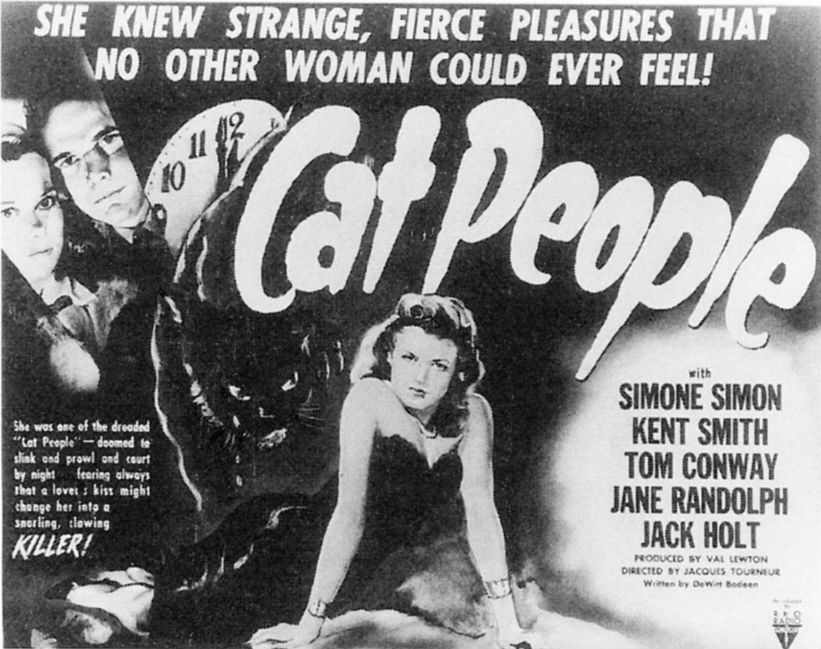
Poster for Cat People, Jacques Tourneur, 1942
Forty years later, Paul Schrader, wanting to take a break from the throes of personal filmmaking, did a remake of Cat People—and ended up making his most personal film. (Desire, indeed, takes circuitous routes.) Throwing out the conventional ending of the script (which had the monster killed and the house burned down), he instead had the hero make love to the monster and ‘put her in a shrine and live with her’. While a far more interesting ending than the one in the screenplay, it nevertheless constitutes, in my view, a failure of nerve.

John Heard, Cat People, Paul Schrader
Indeed, keeping the black panther in a cage, defanging desire, is—while the ‘normal’ fate of a marriage—hardly a sign of courage for such a young couple. The ‘perversity’ that Schrader laments (and blames on his obsession with Nastassia Kinski) is in fact the most stimulating aspect of the movie. As in the 1942 film, the folklore, here spiced up with incest, is a red herring to take the audience off the scent of their own perversity. That scent is strongest in the bondage scene, a scene that Schrader considered to be going ‘a little too far’. In fact, it did not go far enough: How refreshing it would have been to not merely acknowledge the complexity of desire, but to pay homage to it.

Nastassia Kinski, Cat People, Paul Schrader
Then again, Schrader, an intelligent and literate director, is interesting even in his failure (of nerve). He succeeds, for example, in giving a fresh twist to courtly love by mixing it, in the person of his hero, with misanthropy.

John Heard, Cat People, Paul Schrader
Still, cinema induces dream, the images speak in and of themselves, and the black panther is too strong a token of desire to be locked in any sublimation: In the green of Nastassia Kinski’s eyes, I see the film that might have been.
All quotations, unless otherwise noted, are from Schrader on Schrader, ed. Kevin Jackson (Faber & Faber, 1990) pp. 166-67

Nastassia Kinski, Cat People, Paul Schrader
PAUL SCHRADER: THREE BOOKS

Kevin Jackson, Schrader on Schrader

Schrader, Transcendental Style in Film

George Kouvaros, Paul Schrader
